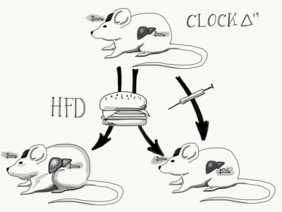Video Link
A network of internal time keepers, the so called circadian clocks, found in all organs of the body help us to align behaviors such as the sleep-wake cycle as well as metabolic functions to the 24-hour day-night rhythm. Food consumption at unusual times – for example in shift workers – can disturb these natural rhythms and promote weight gain and the development of metabolic disorders. Such circadian rhythm disruption can be mimicked in mice, resulting in similar metabolic outcomes.
Circadian Clock gene mutant mice show disrupted 24-hour feeding rhythms and are highly sensitive to the obesogenic effect of a high-fat diet (HFD), resulting in various symptoms of the metabolic syndrome. Meyer-Kovac, Kolbe and co-workers set out to test the extent to which circadian clocks in the liver contribute to this phenotype. By using liver-directed gene therapy they partially reactivated clock function in this tissue of mutant mice. Treated animals showed normalized body weight regulation, 24-h food intake rhythms, energy expenditure, and other metabolic parameters under HFD conditions.
Together, these data show that liver clock function confers resistance against HFD-induced metabolic impairments in mice with circadian clock disruption. Thus, restoring or stabilizing liver clock rhythms might be a promising target for therapeutic interventions in obesity and metabolic disorders.
Contact
Prof. Dr. Henrik Oster
Institute of Neurobiology
Tel. +49 451 3101 4300
Email: henrik.oster(at)uni-luebeck.de
Publication:
Hepatic gene therapy rescues high-fat diet responses in circadian Clock mutant mice. Judit Meyer-Kova, Isa Kolbe, Lea Ehrhardt, Alexei Leliavski, Jana Husse, Gabriela Salinas, Thomas Lingner, Anthony H. Tsang, Johanna L. Barclay and Henrik Oster. Molecular Metabolism 2017. www.sciencedirect.com/science/article/pii/S2212877817301722


